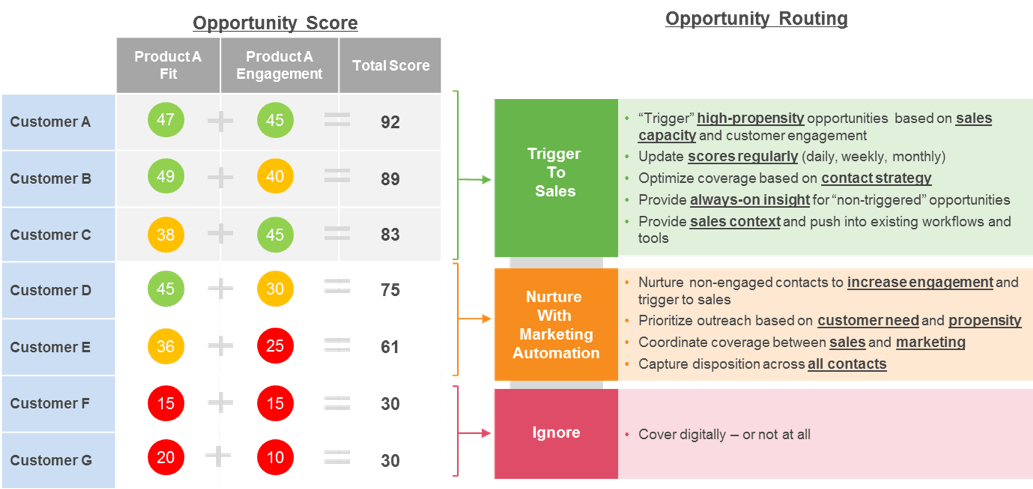Data-Driven Mid-Market Cross-Sell Program
This large financial services firm deployed a data-driven cross-sell program across thousands of mid-market merchants to drive increased product penetration and usage and achieve significant improvements in sales and marketing productivity.
In the recent CMO Survey, FinServ respondents indicated that more than 75% of their marketing investments in growth go towards existing products/services (57%) and new products/services (20%) in existing markets. Cross-sell and upsell programs are one of the fastest growth opportunities available to most firms, and one of the best use cases for advanced analytics.
Want more detail? Download a PDF at the bottom of the page
With a high degree of installed base customer data and product usage/transactional history generally available in most companies, the power of advanced analytics to generate significant lift for cross-sell/upsell programs is especially high. This is particularly true in the SMB and mid-market segments, where account volumes are high, account coverage is broad, and account knowledge is diffused.
The Challenge:
Providing opportunity prioritization across multiple product lines to account managers who are responsible for several hundred accounts each.
With the typical account manager responsible for well over 100 accounts, their ability to identify, prioritize and target cross-sell and upsell opportunities in their account portfolio was limited. Like most sales people, they knew their top accounts very well, but very quickly their account knowledge diminished as they went deeper into the portfolio.
Meanwhile, marketing was running monthly product-specific campaigns to identify leads and direct those into the account managers when customers responded. As a result, the ability for account managers to effectively, efficiently and consistently prioritize their outreach was limited. “Surfing” across the white space in their portfolio while waiting for qualified marketing leads to be passed over was not delivering the required productivity. With new products being launched and competitive pressures high, the company realized that they needed a data-driven approach to account coverage to maximize their cross-sell opportunity in the mid-market installed base, and to enable the sales and marketing productivity gains required to grow profitably.
The Solution:
Deploy product propensity models enhanced with customer buying signals for each product across the portfolio. Update scores weekly and provide prioritized opportunities to the account managers and telesales reps. Provide continuous lead nurture campaigns based on product propensity—not an arbitrary calendar month—to drive engagement and trigger more qualified opportunities to sales.
Product Propensity. For each of the major product lines we developed product propensity models. These models evaluated the characteristics of clients who had previously adopted select products to identify the characteristics most predictive of product adoption. Had usage passed a certain threshold? Were there recurring service issues? Had revenue grown substantially? What other products in the portfolio were predictive of the need for additional products?
This required gathering data from multiple different systems into a marketing data mart, including product usage data, service and support case files, firmographic information, contract data and even credit data. These models were deployed to “score” underlying product propensity for a given product. This helped answer the question of what products should be offered.
Customer Engagement. The propensity models were supplemented with customer engagement data as well to develop a hybrid product opportunity score that reflected both underlying product propensity the what – as well as current levels of customer engagement that were predictive of current need or intent – the when. Was the customer engaging with product information on the website? Did they respond to a campaign? Were they searching for a competitive solution online?
By consolidating additional internal and external signals and updating scores on a regular basis, the models added a current engagement component to the underlying product propensity, providing a consolidated view of both the what and the when. The entire account portfolio was rescored on a weekly basis for all unpenetrated products.
Triggered Outreach. Each week, the top opportunities were “triggered” to the account managers and telesales reps. Based upon agreed-upon business rules including account assignment and product recommendation, the top 30 opportunities for each account manager were “flagged” within salesforce and assigned to the appropriate resource for outreach.
Model scores and related insights were updated on the opportunity record so each account rep knew why that customer triggered for a specific product that week. Reason codes for model scores were displayed in plain English, providing context for the account manager as to why the recommended product was a good fit, and the recent engagement activities that were driving the current week “trigger”.
These insights were key to driving adoption of the solution, and provided the context that made the account manager much more effective in their outreach, as well as confident in the validity of the score.
This solution leveraged current capabilities within salesforce, and beyond the addition of several custom fields on existing salesforce objects, required no additional technology to implement.
Lead Nurture Support. High propensity opportunities with low engagement that were not yet ready for sales outreach were placed into “always-on” nurture campaigns – as opposed to the previous monthly product-based cadence. These opportunities were fed into Eloqua for execution on a weekly basis as well.
Once customer engagement surpassed a certain threshold, these opportunities would be triggered for sales outreach, based on the defined set of business rules. This solution aligned sales and marketing around prioritized needs across the portfolio vs. the monthly product campaign architecture that had been in place previously.
The graphic below illustrates the approach that was used to implement the solution.
The Results:
Cross-sell win rates improved by 34 points from 12% to 46% in the first 8 months.
With prioritized opportunities being triggered in salesforce every Monday morning, improved results were almost immediate. After a brief pilot period with a handful of reps, the program was quickly scaled across the entire account management organization. In the first eight months, the win rate on cross-sell opportunities increased from 12% to 46%.
The account and opportunity intelligence that was provided in salesforce with predictive models was also supplemented with targeted content and messaging for the specific product recommendation and the unique customer segment. This provided account managers with the both the insights and the targeted content and messaging they needed – all on the same object within salesforce. Similarly, this same segmentation was used to target all lead nurture messages through Eloqua, ensuring consistency across the entire buyer’s journey.
The realignment of marketing to support this data-driven approach to customer engagement was a significant enhancement to the previous calendar/product-based approach to campaigns. The result was a much tighter integration between marketing and sales, with marketing focused on nurturing customers over time to improve customer engagement around high propensity products. This end-to-end process also allowed marketing and sales to quickly dial up or dial down activity each week depending on changes in sales capacity, marketing priorities or other business requirements.





